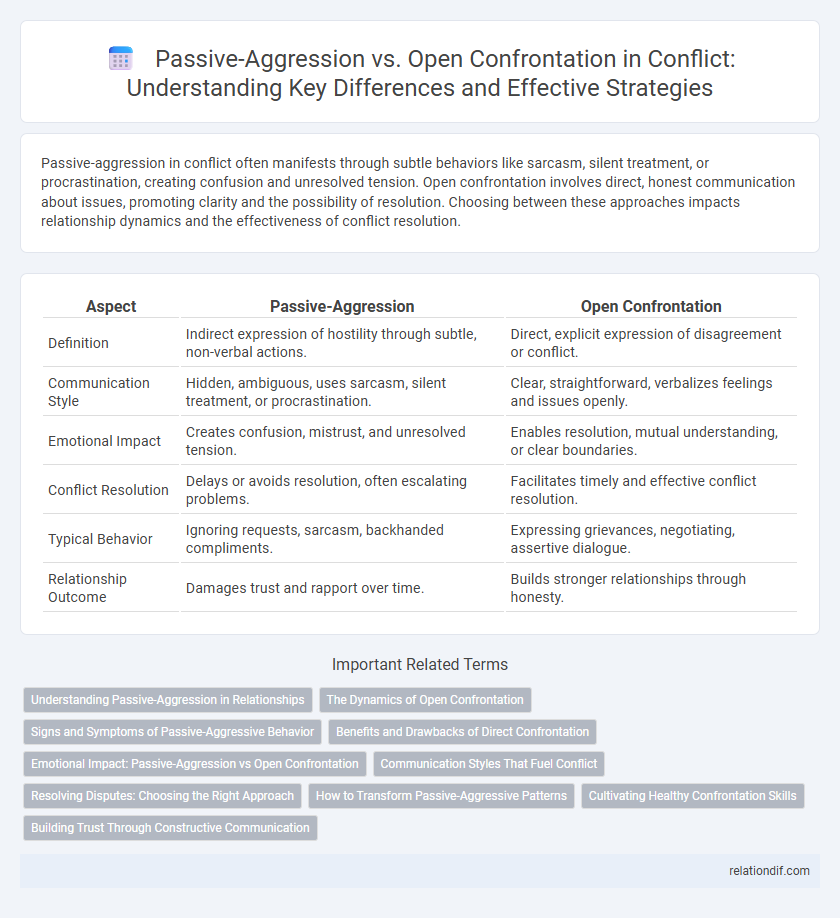Passive-aggression in conflict often manifests through subtle behaviors like sarcasm, silent treatment, or procrastination, creating confusion and unresolved tension. Open confrontation involves direct, honest communication about issues, promoting clarity and the possibility of resolution. Choosing between these approaches impacts relationship dynamics and the effectiveness of conflict resolution.
Table of Comparison
| Aspect | Passive-Aggression | Open Confrontation |
|---|---|---|
| Definition | Indirect expression of hostility through subtle, non-verbal actions. | Direct, explicit expression of disagreement or conflict. |
| Communication Style | Hidden, ambiguous, uses sarcasm, silent treatment, or procrastination. | Clear, straightforward, verbalizes feelings and issues openly. |
| Emotional Impact | Creates confusion, mistrust, and unresolved tension. | Enables resolution, mutual understanding, or clear boundaries. |
| Conflict Resolution | Delays or avoids resolution, often escalating problems. | Facilitates timely and effective conflict resolution. |
| Typical Behavior | Ignoring requests, sarcasm, backhanded compliments. | Expressing grievances, negotiating, assertive dialogue. |
| Relationship Outcome | Damages trust and rapport over time. | Builds stronger relationships through honesty. |
Understanding Passive-Aggression in Relationships
Passive-aggression in relationships manifests through indirect expressions of hostility, such as sarcasm, stubbornness, or deliberate procrastination, which can undermine trust and communication over time. Unlike open confrontation, where issues are addressed directly and transparently, passive-aggressive behavior often leads to misunderstandings and unresolved conflicts, eroding emotional intimacy. Recognizing passive-aggression patterns enables partners to foster more honest dialogues, promoting healthier conflict resolution and emotional well-being.
The Dynamics of Open Confrontation
Open confrontation involves direct expression of concerns and emotions, enabling clearer communication and quicker resolution of conflicts. This dynamic often leads to immediate feedback, fostering mutual understanding and reducing the likelihood of misunderstandings. However, the intensity of open confrontation can escalate tensions if not managed with emotional intelligence and respect.
Signs and Symptoms of Passive-Aggressive Behavior
Passive-aggressive behavior often manifests through subtle signs such as sarcasm, procrastination, and intentional inefficiency, which convey hidden resistance without direct expression. Individuals displaying these symptoms may exhibit frequent forgetfulness, silent treatment, or indirect criticism, causing confusion and tension in relationships. Recognizing these patterns is crucial for addressing underlying conflicts and promoting healthier communication dynamics.
Benefits and Drawbacks of Direct Confrontation
Direct confrontation enables clear communication of grievances, promoting resolution and mutual understanding in conflict situations. However, it may escalate tensions and lead to emotional distress or damaged relationships if not managed with empathy and respect. The effectiveness of open confrontation depends on the context, cultural norms, and individuals' conflict management skills.
Emotional Impact: Passive-Aggression vs Open Confrontation
Passive-aggression often leads to confusion and prolonged emotional stress as underlying issues remain unaddressed, causing frustration and resentment to build silently over time. In contrast, open confrontation allows for direct expression of feelings and concerns, promoting clarity and resolution, which can alleviate anxiety and foster emotional relief. Choosing transparency in conflicts tends to support healthier relationships by enabling mutual understanding and emotional validation.
Communication Styles That Fuel Conflict
Passive-aggression involves indirect expressions of hostility, such as sarcasm or silent treatment, which obscure true feelings and hinder conflict resolution. Open confrontation, by contrast, features direct communication where parties explicitly state grievances and seek mutual understanding. Communication styles that avoid transparency often escalate conflicts, while honest dialogue promotes clearer understanding and effective problem-solving.
Resolving Disputes: Choosing the Right Approach
Passive-aggression often prolongs conflicts by masking true feelings, making resolution challenging and communication ineffective. Open confrontation, when managed constructively, promotes transparency and allows parties to address issues head-on, fostering faster reconciliation. Selecting the appropriate approach depends on the conflict's intensity, relationship dynamics, and the desired outcome of resolution.
How to Transform Passive-Aggressive Patterns
Transforming passive-aggressive patterns into healthier communication involves recognizing indirect behaviors such as sarcasm, procrastination, or silent treatment and consciously choosing transparent expression of feelings. Employing assertiveness training and encouraging open dialogue fosters emotional honesty, reducing misunderstandings and resentment. Consistent practice of active listening and setting clear boundaries promotes resolution and strengthens interpersonal relationships in conflict situations.
Cultivating Healthy Confrontation Skills
Cultivating healthy confrontation skills involves recognizing passive-aggression as a barrier to effective communication and addressing conflicts with clarity and respect. Open confrontation encourages honest dialogue, fostering mutual understanding and resolution without escalating tensions. Developing assertiveness and active listening enhances emotional intelligence and strengthens interpersonal relationships.
Building Trust Through Constructive Communication
Passive-aggression hinders trust by fostering ambiguity and resentment, while open confrontation encourages clear expression of concerns and mutual understanding. Constructive communication techniques, such as active listening and empathetic responses, facilitate transparency and respect, essential for rebuilding trust. Establishing consistent dialogue promotes emotional safety, reduces misunderstandings, and strengthens interpersonal relationships in conflict resolution.
Passive-aggression vs Open confrontation Infographic

 relationdif.com
relationdif.com